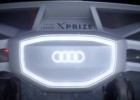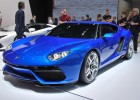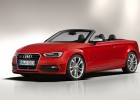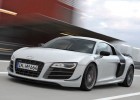Lightweight construction with continuity: Audi milestones
Lightweight construction has long been a driving force at Audi. Development work on the ASF body began back in the early 1980s. Audi has been building cars with aluminum bodies since 1994 – with a high degree of continuity, in contrast to its competitors.
Audi Sport quattro (1984)
The Sport quattro is a brand icon. Beginning in 1984, Audi built 214 units by hand in order to homologize its new competition car for the Rally World Championship. The five-cylinder turbo, which displaced just 2.1 liters, produced 225 kW (306 hp) in the street version, making it one of a small group of extreme sports cars at the time.
The Sport quattro had a wheelbase that was 32 centimeters (1.05 ft) shorter than that of the model on which it was based, the Ur-quattro (original quattro). 4.16 meters (13.65 ft) long, it weighed just 1,300 kilograms (2,866.01 lb) thanks to extreme lightweight construction. Only the bodyshell and the doors of the “Shorty,” the latter taken from the Audi 80, were made of steel sheet. The rear hatch was made of a polyester material.
Most of the body components – the front and rear fenders, the front skirt, the hood, the outer shells of the B- and C-pillars, the roof and the rear skirt – were made of a material developed specifically for the project. This was a resin laminate into which multiple woven elements of aramid and glass fiber were embedded. Audi developed many new technologies for working with this material, from presses to high-pressure water cutting to joining with screws, rivets and adhesive.
The aramid composite material achieved nearly the same torsional rigidity as conventional steel sheet, but was almost three times lighter. The weight of the body was reduced by 64.2 kilograms (141.54 lb). The hood was additionally reinforced with carbon fiber in the area cutout for the intercooler. It cost DM 3,500 as an individual part.
The Audi A8 (1994)
Lightweight construction took on the rank of a strategic project at Audi in 1982. The objective meant reinventing the self-supporting body with a new material and a geometry specifically tailored to it.
The development work was extensive and resulted in 40 patents and patent applications in addition to broad-based fundamental expertise. In 1985, Audi presented the body of an Audi 100 made of aluminum but still using a traditional monocoque design. The concept sports cars from 1991, the Audi Avus quattro and the Audi quattro Spyder, also had skins of the light metal but underneath were still supporting frames.
The new technology was ready for series production in 1993, however. A shining silver showcar with an unpainted body of polished aluminum was on display at the International Motor Show in Frankfurt am Main, Germany. The predecessor to the A8 bore the designation ASF, the abbreviation for Audi Space Frame.
The production model that debuted the following year was the world’s first large-volume production car with a self-supporting aluminum body. The superstructure of the A8 weighed just 249 kilograms (548.95 lb) and featured the same construction that is still used today. Panels accounted for most of its 336 individual components, followed by the sections and castings. Assembly was performed roughly 75 percent by hand.
The Audi A2 (2000)
The Audi A2 was the second Audi ASF model. Just 3.83 meters (12.57 ft) long, it boasted agile performance and amazing efficiency. The base model of the small van weighed only 895 kilograms (1,973.14 lb). The A2 1.2 TDI, the world’s first five-door three-liter car, weighed just 825 kilograms (1,818.81 lb). Its average fuel consumption of 2.99 liters/100 km (78.67 US mpg) remains unsurpassed today.
The key factor in this was the aluminum body, which tipped the scales at just 156 kilograms (343.92 lb). Designed for higher volumes than the A8, it used important refinements and new developments in the areas of tools, casting and joining processes. The number of individual parts was reduced to 238. The B-pillar, for instance, comprised a single large casting. The B-pillar of the luxury sedan was still assembled from eight components.
Aluminum panels also accounted for the greatest share of semi-finished components in the A2, followed by sections and castings. The underbody frame was made up of straight extruded sections that were joined directly together by means of MIG welding (MIG = metal inert gas), eliminating the nodes required in the A8. Three joining processes, including state-of-the-art laser welding, sufficed for assembly. The degree of automation reached roughly 85 percent.
The Audi TT (2006)
The second generation of the TT features a groundbreaking Audi innovation – hybrid aluminum and steel construction. The front end, the floor and the superstructure of the compact sports car are made of aluminum, with deep drawn steel being used for the doors and the trunk lid. The rear section of the floor assembly, the tail panel and the bulkhead of the Roadster are made of high-strength steel. This material mix provides for an optimal distribution of axle loads and thus for dynamic handling.
The ASF body of the TT Coupé weighs in at 206 kilograms (454.15 lb); that of the TT Roadster at 251 kilograms (553.36 lb). Compared to the previous model with its steel body, the curb weight decreased by 20 to 90 kilograms (44.09 to 198.42 lb) depending on the model. Audi reversed the weight spiral. The material mix is dominated by aluminum, which accounts for 68 percent of the Coupé’s weight and 58 percent of the Roadster’s. In the TT Coupé, the aluminum fraction comprises 63 kilograms (138.89 lb) of panels, 45 kilograms (99.21 lb) of castings and 32 kilograms (70.55 lb) of extruded sections.
The ASF body of the Audi TT is the ideal solution for a sports car. Compared to the preceding model, static torsional rigidity increased by 50 percent in the Coupé and 100 percent in the Roadster. This lays the foundation for precise, dynamic handling, while also being responsible for the high vibrational comfort and superior crash safety. In 2006 Audi won the Euro Car Body Award, the world’s most important prize for innovative car body design, for the ASF body of the TT.
The Audi R8 (2007)
The ASF body of the R8 set new standards. The body is unmatched in the high-performance sports car segment in terms of lightweight quality – the relationship between size, weight and rigidity.
Weighing 210 kilograms (462.97 lb), the superstructure of the R8 Coupé makes extensive use of extruded sections, which account for 70 percent of the total. Vacuum-cast nodes account for 8 percent, and aluminum panels make up the remaining 22 percent. A magnesium engine frame provides added rigidity in the upper section of the rear end. Custom tailored blanks reinforce the center tunnel. The individual panels vary in thickness depending on where they are used.
Plastic is used for the R8’s front fenders and the sill liners. The hood of the Coupé is made of composite materials; the side blades are optionally available in carbon fiber-reinforced plastic (CFRP).
In the R8 Spyder (body weight: 216 kilograms (476.20 lb)), profiles dominate the mix even more clearly than in the Coupé, accounting for 75 percent. The structure of the open high-performance sports car integrates the rear side walls and the cover of the storage compartment for the top as load-bearing CFRP components.
Audi reduced the weight of the exclusive, top-of-the-line R8 GT by 100 kilograms (220.46 lb) to 1,525 kilograms (3,362.05 lb). Made of CFRP, the rear trunk lid, the back bumper and the side blades account for 13.3 kilograms (29.32 lb) of this; the thin aluminum cover over the luggage compartment is good for an addition 2.6 kilograms (5.73 lb). Glazings of thinner glass or polycarbonate shave off nine kilograms (19.84 lb).
In the passenger compartment, lightweight carpeting and a seat frame of glass-fiber-reinforced plastic reduce the weight by 7.9 and 31.5 kilograms (17.42 and 69.45 lb), respectively.
The Audi A8 (2010)
The third generation of the A8 once again features great advancements in the ASF principle. The material mix of the body, comprised of 251 individual parts, includes 13 different grades of aluminum. The superstructure also integrates ultra-high-strength B-pillars of hot-shaped steel – a groundbreaking step. The body of the sedan with the standard wheelbase weighs just 231 kilograms (509.27 lb); 10 kilograms (22.05 lb) more in the A8 L.
Besides the steel B-pillars, which account for 8 percent of the weight, aluminum castings and panels each account for 35 percent and extruded sections for 22 percent. The combined weight of the 25 castings, most of which are made of advanced alloys, is three kilograms (6.61 lb) less than with the previous model. Most of them are manufactured using the very high-precision vacuum casting process.
Audi has increased the strength of the higher-strength body components by as much as 25 percent, thereby reducing both material thickness and weight by up to 20 percent. The fusion alloy for the aluminum panels alone saves 6.5 kilograms (14.33 lb) of weight. Fifteen fusion panels are used for the load-bearing parts of the structure. The Euro Car Body Award that Audi received in late 2010 documents the innovation density of the A8 body.
The Audi A6 (2011)
The bodies of the new Audi A6 and the A7 Sportback are also best-in-class. A hybrid steel-aluminum construction, they weigh roughly 15 percent less than a comparable all-steel body. They are made up of more than 20 percent aluminum, making them roughly 30 kilograms (66.14 lb) lighter than that of the previous A6 model.
The hybrid concept, in which the aluminum components are largely concentrated in the front end, improves the axle load distribution. Most importantly, though, it provides the basis for systematic lightweight construction. Depending on the version, the A6 weighs as much as 80 kilograms (176.37 lb) less than its predecessor. Audi has reversed the weight spiral yet again.
The crossbar in the engine compartment and the cross-members behind the front and rear bumpers are aluminum sections. The front strut domes are aluminum castings. The integral subframe behind the instrument panel, the rear shelf, the bulkhead to the trunk, the cross-member in the trunk, the front fenders, the doors, the hood and the trunk lid are made of aluminum panels. A new pretreatment process ensures that the steel and aluminum components can be painted in exactly the same way.
The passenger compartment of both the A6 and the A7 Sportback includes components made of hot-shaped steel. They can be found in the transition from the front section of the car to the passenger cell, in the A-pillars and the roof arch, as reinforcements for the center tunnel and the side sills, at the transition of the side sills to the rear section of the car, as cross-bracings in the floor panel and as B-pillars. In many zones, such as the bulkhead cross-connection, Audi uses tailored blanks. These are sheets of different thicknesses that have been rolled in some cases to different thicknesses.
In some areas, the steel components in the body already follow the ASF principle. The A6 and the A7 Sportback represent the gradual transition from the monocoque design to the new Multimaterial Space Frame (see separate section).
Experience lightweight construction – test cars at Tech Day
The customer benefits directly from Audi’s lightweight construction – it makes the cars more efficient and more dynamic. These strengths can be experienced first hand in drives on the test track and on public highways at Tech Day.
Test 1: Audi A6 comparison
Two Audi A6 3.0 TDI quattro models – the outgoing model and the new successor model in a comparison test. Thanks to the systematic lightweight construction concept, the new sedan weighs up to 80 kilograms (176.37 lb) less than the predecessor model. The difference is clearly noticeable while driving. The new A6 seems a decisive tick sportier, more spontaneous and more agile in all criteria.
Test 2: Test drive with weight-optimized Audi TT
An Audi TTS Coupé model with a range of weight-optimizing measured acts as a technology platform which is already geared toward the next generation of the model series. The 2.0 TFSI produces 200 kW (272 hp) as standard and delivers its power to the quattro drivetrain via a six-speed S tronic transmission.
With its hybrid body, the production model of the TTS is already unusually light with a curb weight of only 1,470 kilograms (3,240.80 lb). In the prototype, add-on parts of carbon fiber-reinforced plastic, in particular the special lightweight seats and other individual components, save another 80 kilograms (220.46 lb), an effect that is most noticeable in the increased lateral dynamics.
Special features can also be found in the passenger compartment. The driving modes of the S tronic on the prototype are selected using buttons. The rings of the scales in the instrument cluster are illuminated in white in D mode, red in the sporty S mode.
Test 3: Driving experience with the technology of the Audi quattro concept showcar
An especially attractive technology platform can be experienced in the form of an Audi A5.
The lightweight 2.5 TFSI 5-cylinder turbocharged engine with 300 kW (408 hp), familiar from the quattro concept showcar, accelerates the test vehicle. The body of the is hand-built from aluminum components according to the ASF principle. Add-on parts such as the hood and the rear hatch are made of a carbon fiber composite material. Lightweight sport seats are installed up front. This one-off model weighs just 1,400 kilograms (3,086.47 lb).
Its power-to-weight ratio is 3.4 kilograms (8.16 lb) per hp, better than even that of the Audi RS 5, whose 4.2-liter V8 produces 331 kW (450 hp). The technology platform’s performance is awesome, when accelerating, when braking and especially when cornering.
The Audi quattro concept, of which a 1:4 scale model will be on display at Tech Day, is the ideal successor to the Audi Sport quattro from 1984. This is true for the compact length of 4.28 meters (14.04 ft), for the powerplant – a five-cylinder turbo with 300 kW (408 hp) – and for the low weight of around 1,300 kilograms (2,866.01 lb). Each hp only has to move 3.2 kilograms (7.05 lb) of weight, leading to exhilarating performance.
The quattro concept catapults from 0 to 100 km/h (62.14 mph) in just 3.9 seconds.
Unlike the 1980s classic, the Audi quattro concept has a body of aluminum. This is assembled in typical ASF fashion from extruded sections, pressure diecast components and aluminum panels.
The bodyshell weighs only 159 kilograms (350.53 lb), around 40 percent less than a comparable body made of steel sheet. The hood, the rear hatch and the moveable spoiler are made of a carbon fiber-reinforced composite.
SOURCE Audi of America




















